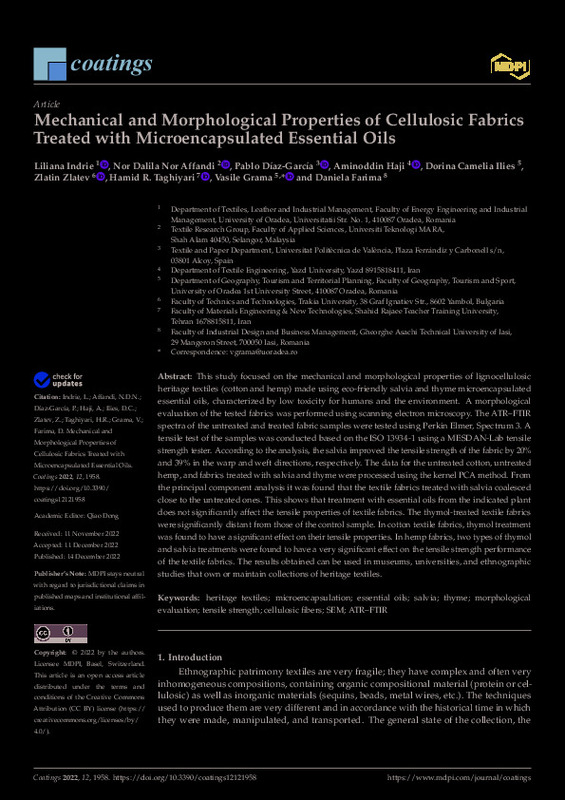JavaScript is disabled for your browser. Some features of this site may not work without it.
Buscar en RiuNet
Listar
Mi cuenta
Estadísticas
Ayuda RiuNet
Admin. UPV
Mechanical and Morphological Properties of Cellulosic Fabrics Treated with Microencapsulated Essential Oils
Mostrar el registro sencillo del ítem
Ficheros en el ítem
| dc.contributor.author | Indrie, Liliana
|
es_ES |
| dc.contributor.author | Affandi, Nor Dalila Nor
|
es_ES |
| dc.contributor.author | Díaz-García, Pablo
|
es_ES |
| dc.contributor.author | Haji, Aminoddin
|
es_ES |
| dc.contributor.author | Ilies, Dorina Camelia
|
es_ES |
| dc.contributor.author | Zlatev, Zlatin
|
es_ES |
| dc.contributor.author | Taghiyari, Hamid R.
|
es_ES |
| dc.contributor.author | Grama, Vasile
|
es_ES |
| dc.contributor.author | Farima, Daniela
|
es_ES |
| dc.date.accessioned | 2023-07-21T18:04:13Z | |
| dc.date.available | 2023-07-21T18:04:13Z | |
| dc.date.issued | 2022-12 | es_ES |
| dc.identifier.uri | http://hdl.handle.net/10251/195319 | |
| dc.description.abstract | [EN] This study focused on the mechanical and morphological properties of lignocellulosic heritage textiles (cotton and hemp) made using eco-friendly salvia and thyme microencapsulated essential oils, characterized by low toxicity for humans and the environment. A morphological evaluation of the tested fabrics was performed using scanning electron microscopy. The ATR-FTIR spectra of the untreated and treated fabric samples were tested using Perkin Elmer, Spectrum 3. A tensile test of the samples was conducted based on the ISO 13934-1 using a MESDAN-Lab tensile strength tester. According to the analysis, the salvia improved the tensile strength of the fabric by 20% and 39% in the warp and weft directions, respectively. The data for the untreated cotton, untreated hemp, and fabrics treated with salvia and thyme were processed using the kernel PCA method. From the principal component analysis it was found that the textile fabrics treated with salvia coalesced close to the untreated ones. This shows that treatment with essential oils from the indicated plant does not significantly affect the tensile properties of textile fabrics. The thymol-treated textile fabrics were significantly distant from those of the control sample. In cotton textile fabrics, thymol treatment was found to have a significant effect on their tensile properties. In hemp fabrics, two types of thymol and salvia treatments were found to have a very significant effect on the tensile strength performance of the textile fabrics. The results obtained can be used in museums, universities, and ethnographic studies that own or maintain collections of heritage textiles. | es_ES |
| dc.description.sponsorship | We acknowledge the partial contribution of the University of Oradea Grants Competition, Scientific Research of Excellence Related to Priority Areas with Capitalization through Technology Transfer: INO-TRANSFER-UO- Second edition, project no. 232/28.10.2022, title of the project Reuse of textile waste in interior decorations. | es_ES |
| dc.language | Inglés | es_ES |
| dc.publisher | MDPI AG | es_ES |
| dc.relation.ispartof | Coatings | es_ES |
| dc.rights | Reconocimiento (by) | es_ES |
| dc.subject | Heritage textiles | es_ES |
| dc.subject | Microencapsulation | es_ES |
| dc.subject | Essential oils | es_ES |
| dc.subject | Salvia | es_ES |
| dc.subject | Thyme | es_ES |
| dc.subject | Morphological evaluation | es_ES |
| dc.subject | Tensile strength | es_ES |
| dc.subject | Cellulosic fibers | es_ES |
| dc.subject | SEM | es_ES |
| dc.subject | ATR-FTIR | es_ES |
| dc.subject.classification | INGENIERIA TEXTIL Y PAPELERA | es_ES |
| dc.title | Mechanical and Morphological Properties of Cellulosic Fabrics Treated with Microencapsulated Essential Oils | es_ES |
| dc.type | Artículo | es_ES |
| dc.identifier.doi | 10.3390/coatings12121958 | es_ES |
| dc.relation.projectID | info:eu-repo/grantAgreement/Universitatea din Oradea//232%2F28.10.2022//Reuse of textile waste in interior decorations/ | es_ES |
| dc.rights.accessRights | Abierto | es_ES |
| dc.contributor.affiliation | Universitat Politècnica de València. Escuela Politécnica Superior de Alcoy - Escola Politècnica Superior d'Alcoi | es_ES |
| dc.description.bibliographicCitation | Indrie, L.; Affandi, NDN.; Díaz-García, P.; Haji, A.; Ilies, DC.; Zlatev, Z.; Taghiyari, HR.... (2022). Mechanical and Morphological Properties of Cellulosic Fabrics Treated with Microencapsulated Essential Oils. Coatings. 12(12):1-16. https://doi.org/10.3390/coatings12121958 | es_ES |
| dc.description.accrualMethod | S | es_ES |
| dc.relation.publisherversion | https://doi.org/10.3390/coatings12121958 | es_ES |
| dc.description.upvformatpinicio | 1 | es_ES |
| dc.description.upvformatpfin | 16 | es_ES |
| dc.type.version | info:eu-repo/semantics/publishedVersion | es_ES |
| dc.description.volume | 12 | es_ES |
| dc.description.issue | 12 | es_ES |
| dc.identifier.eissn | 2079-6412 | es_ES |
| dc.relation.pasarela | S\479470 | es_ES |
| dc.contributor.funder | Universitatea din Oradea | es_ES |








